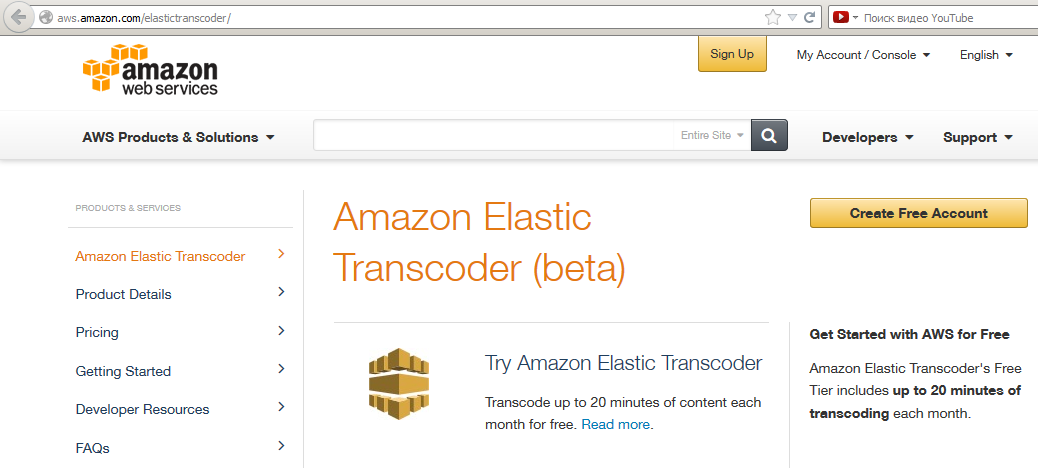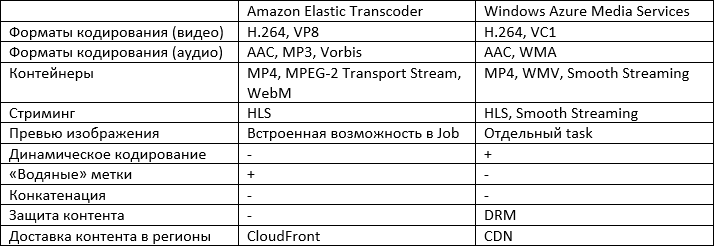Windows Azure Media Services vs. Amazon Elastic Transcoder. Part 3: Comparison
- Tutorial
Good day to all residents of Habr! Let me remind you that the last time I described working with cloud-based multimedia services: Windows Azure Media Services and Amazon Elastic Transcoder. Naturally, the mechanism for working with the SDK described by me is not the only one. Of course, there is still the possibility of working through the REST API, UI or CLI, but it is impossible to embrace everything in one article. Therefore, I hope the beginning of the "investment" of these services has been laid. I just had to compare these services with each other. Go!
It should be noted that, as I already noted in the description of Amazon Elastic Transcoder, despite the release of the SDK for this service, it has several errors that will need to be circumvented when working with it. In addition, unlike Windows Azure Media Services, Amazon's cloud service is in beta mode. Accordingly, no one guarantees its stable operation.

However, let's try to compile a table of the capabilities of cloud multimedia services.

Consider the capabilities of each of the services in more detail.
Windows Azure Media Services supports the so-called Dynamic Packaging. If in short, then you put on a storage file, in only one format and specify a description (asset) in which formats this file will be available. When you request such a file for viewing, it will be automatically encoded in the format necessary for the client, thereby reducing the cost of storage (see the detailed description ).
Amazon Elastic Transcoder allows you to insert the so-called watermarks when encoding video. The image can be any JPEG or PNG file.
Unfortunately, both services currently do not support the ability to glue several input files into one (concatenation).
To protect content, Windows Azure Media Services offers DRM technology, which, as you know, is not supported on all devices.
And finally, the most interesting thing is price comparison. However, here, too, several differences should be noted. Windows Azure Media Services takes money for encoding video and for broadcasting it in live (on-demand streaming) mode, and Amazon Elastic Transcoder only for encoding.
Another difference is that Microsoft takes money both for input multimedia data (input data) and for coding in the output (output data) formats, while Amazon only for the weekend. This refers to the encoding process itself, not storage. As for storage, both providers charge a fee for using it both for input and output.
As for video encoding, Amazon Elastic Transcoder charges a fee depending on the duration of the video output format. At the same time, Windows Azure Media Services aims at the size of the video in gigabytes and charges for the number of gigabytes of processed video per month. By the way, in the case of Amazon Elastic Transcoder, the video duration is always rounded to minutes. That is, let's say a video lasting 4 minutes 38 seconds will cost the same as 5 minutes and 4 minutes 54 seconds, etc.
Thus, it is clear that comparing services in connection with different pricing is not a trivial task. However, let's try to create an appropriate table.

Well, we see quite interesting results. As you can see the main role in the comparison of Elastic Transcoder vs. Media Services plays a couple of file length / size. I would venture to suggest that Windows Azure Media Services is more attractive in terms of price when processing small video, while Amazon Elastic Transcoder is focused on processing large files.
That’s all for me. Thanks to everyone who followed the publications and have a nice day!
Opportunities
It should be noted that, as I already noted in the description of Amazon Elastic Transcoder, despite the release of the SDK for this service, it has several errors that will need to be circumvented when working with it. In addition, unlike Windows Azure Media Services, Amazon's cloud service is in beta mode. Accordingly, no one guarantees its stable operation.

However, let's try to compile a table of the capabilities of cloud multimedia services.

Consider the capabilities of each of the services in more detail.
Amazon Elastic Transcoder
- The service supports encoding video in H.264 and VP8 formats.
- AAC, MP3 and OGG Vorbis can be used as the output audio format, which Microsoft does not have.
- The container can be MP4, MPEG2-TS and open WebM.
- Video streaming is in HLS format.
- To generate “previews” there is a built-in feature when creating a Job (see the description of working with Amazon Elastic Transcoder , the ThumbnailPattern property).
- CloudFront can be used to deliver content to regions.
Windows Azure Media Services
- The service supports encoding video in H.264 and VC1 formats.
- AAC and, of course, Microsoft's own format, WMA, can be used as the output audio format.
- MP4 and its own formats can act as a container: WMV, Smooth Streaming.
- Video streaming is carried out in HLS and Smooth Streaming formats.
- To generate “previews” you need to create a separate task (see here).
- A CDN service can be used to deliver content to regions.
Differences
Windows Azure Media Services supports the so-called Dynamic Packaging. If in short, then you put on a storage file, in only one format and specify a description (asset) in which formats this file will be available. When you request such a file for viewing, it will be automatically encoded in the format necessary for the client, thereby reducing the cost of storage (see the detailed description ).
Amazon Elastic Transcoder allows you to insert the so-called watermarks when encoding video. The image can be any JPEG or PNG file.
Unfortunately, both services currently do not support the ability to glue several input files into one (concatenation).
To protect content, Windows Azure Media Services offers DRM technology, which, as you know, is not supported on all devices.
Prices
And finally, the most interesting thing is price comparison. However, here, too, several differences should be noted. Windows Azure Media Services takes money for encoding video and for broadcasting it in live (on-demand streaming) mode, and Amazon Elastic Transcoder only for encoding.
Another difference is that Microsoft takes money both for input multimedia data (input data) and for coding in the output (output data) formats, while Amazon only for the weekend. This refers to the encoding process itself, not storage. As for storage, both providers charge a fee for using it both for input and output.
As for video encoding, Amazon Elastic Transcoder charges a fee depending on the duration of the video output format. At the same time, Windows Azure Media Services aims at the size of the video in gigabytes and charges for the number of gigabytes of processed video per month. By the way, in the case of Amazon Elastic Transcoder, the video duration is always rounded to minutes. That is, let's say a video lasting 4 minutes 38 seconds will cost the same as 5 minutes and 4 minutes 54 seconds, etc.
Comparison
Thus, it is clear that comparing services in connection with different pricing is not a trivial task. However, let's try to create an appropriate table.

Well, we see quite interesting results. As you can see the main role in the comparison of Elastic Transcoder vs. Media Services plays a couple of file length / size. I would venture to suggest that Windows Azure Media Services is more attractive in terms of price when processing small video, while Amazon Elastic Transcoder is focused on processing large files.
That’s all for me. Thanks to everyone who followed the publications and have a nice day!
